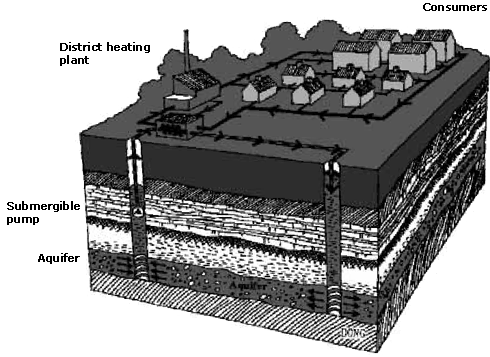Danish - Lithuanian Environmental Co-operation 1991-2000
Chapter 5
Getting a better quality of air
Projects described:
Exploitation of Geothermal Energy
in Klaipeda
In recent years, atmospheric pollution in Lithuania has decreased due to the drop in economic activities. Approximately 70 per cent of all emissions into the atmosphere are generated by mobile sources. Apart from the polluting transport sector, the main stationary emission sources are in the energy, petrochemical and metal industries, construction and building materials industries.
Being responsible for 70 percent of all emissions into the atmosphere, the transport sector is by far the biggest polluter of the air in Lithuania, but also the industry and the energy sector are seen as serious contributors to the pollution of the atmosphere.
Nevertheless, only relatively few DANCEE projects are targeted directly at the industry and energy sector since this area is a main target of the Energy Sector Programme administered by the Danish Energy Agency.
The establishment of a geothermal demonstration plant in Klaipeda has however received substantial grant support from the DANCEE programme, and DANCEE has also supported the establishment of a biogas demonstration plant at Rokai, south of Kaunas.
The overall objective of the Energy Sector Programme (see chapter 15) is to support the development of an environmentally sustainable energy sector, reducing the emission of CO2, SO2 and NOx from the energy production. As such this programme supports improvements in energy supply efficiencies, cleaner energy sources, promotion of renewable energy, energy saving at the end-user and institutional capacity development.
The energy sector programme is supplemented by the sector programme implemented by the Danish Ministry of Housing and Urban Affairs (see chapter 16) targeting energy saving at domestic households.
The support to cleaner technologies development in Lithuanian industries and sectors also positively contribute to air pollution abatement.

Exploitation of Geothermal Energy in Klaipeda
In Lithuania, an attractive alternative to coal is available in form of indigenous geothermal energy. This provides a costeffective alternative to other low-polluting fuels such as natural gas. Lithuania has limited domestic energy resources and almost totally depends on imported fuels from Russia. Following a National Energy Strategy which calls for closure of Ignalina Nuclear Power Plant, alternative energy resources become of vital importance to the country. One of the areas in Lithuania where geothermal fields have been investigated is Klaipeda district.
Geothermal energy produces almost no pollution in terms of particulate matter, sulphur dioxide, nitrogen oxides, or aromatic hydrocarbons. It has the additional advantage compared with natural gas that it produces almost no carbon oxides.
The geothermal resource is situated in a series of Lower Devonian aquifer sands underlying Klaipeda district at a depth of about 1,200 meters. Klaipeda was found to have superior aquifer conditions, and sufficient geothermal temperature conditions to allow for a demonstration of the extraction of geothermal energy.
The objective
Apart from the considerable environmental advantages of geothermal energy, there are likely to be long-term cost advantages as well. Lithuanian government policy supports the use of renewable energy resources in relation to the closure of Ignalina Nuclear Power Plant and as means of achieving higher air quality standards. An additional cost advantage of geothermal energy is that it can be distributed through the existing district heating networks, which means that there is limited need for major infrastructure investments.
The procedure
The project consists of two components: (a) A technical assistance and training component, and (b) an investment component. Both components have been financed partly by grants from the Global Environmental Facility (GEF), the Danish Government, a loan from the World Bank, and local contribution.
The technical assistance and training component comprises design of necessary equipment for extracting heat from the geothermal water and transferring it to the district heating system, preparation of detailed design, testing and completion of programs, management support for project implementation including preparation of tender documents, and construction supervision, and training of the Lithuanian staff in the operation of the plant. The investment component covered establishment of two production wells and one injection well above ground facilities and piping between production wells, the geothermal plant, injection well and the district heating network.
The environmental result
The geothermal plant in Klaipeda has a capacity comparable to the heating needs of 7.000 Danish one family houses. The plant will substitute fossil fuel heat production and this will lead to yearly reductions in CO2 emissions of 46.000 tons. As the plant will substitute heat production from the fossil fuel mazut which is a heavy oil with a high sulphur content and nitrogen, the yearly reductions in emissions of sulphur dioxide and nitrogen oxides are also huge (900 and 100 tons respectively). The reductions in CO2 emissions are important in the perspective of climate changes as CO2 impairs heat loss from earth (a so called green house gas), whereas sulphur dioxide and nitrogen oxide leads to acid rain which negatively affects a range of different types of ecosystems throughout the Baltic Region.
Geothermal heat is heat produced in the waterbearing aquifers in the underground as a result of heat from the earth rising towards the surface. The heat is produced by drilling wells at these layers and pumping the water through a geothermal production plant where the heat is conveyed to a district heating system by means of direct heat exchange and in some cases also heating pumps. The cooled water is then led back to the same waterbearing aquifer by means of injection wells. The locations which are most appropriate for such technique are locations with a considerable district heating system with low temperature level and having an underground with suitable waterbearing layers, i.e. a thick sand layer. Such layers are typically found at 1-3 km depth containing 30-100 degrees C hot water. |

Principle of Geothermal Heating System